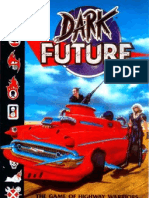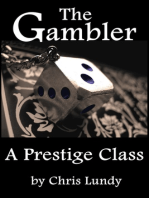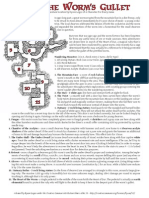Bag of Problems
Bag of Problems
Uploaded by
Foxtrot OscarCopyright:
Available Formats
Bag of Problems
Bag of Problems
Uploaded by
Foxtrot OscarOriginal Description:
Copyright
Available Formats
Share this document
Did you find this document useful?
Is this content inappropriate?
Copyright:
Available Formats
Bag of Problems
Bag of Problems
Uploaded by
Foxtrot OscarCopyright:
Available Formats
BAG OF PROBLEMS Roll 1 2 3 4 5 6 7 8 9 10 11 12 13 14 15 16 17 18 19 20 Target (d20) Ground/Cavern Chasm Fire Water Plant/Forest Animal (B) Monster (B) Materials
(A) Information (A) Wall/Cliff Bridge Road/Passage Building/Chamber Object (A) Door Statue Vehicle (A) Food/Drink (A) Person (B) Group (B) Action (d10) Cross (A, B: Release) Ascend (A, B: Contain) Descend (A: Steal; B: Rescue) Enter (A, B: Substitute) Escape (A, B: Move) Build (B: Convince) Destroy/Damage (B: Chase away) Investigate Protect Change appearance of
(c) Roger S. G. Sorolla 2011 Complication (d12 or d20) In pitch darkness Without being seen Without being heard Competing with someone else Under time pressure With someone trying to stop you Without using the most obvious kind of resource In an extreme environment (hot, cold, windy, wet) Leaving no trace You have to stop someone else from doing the challenge instead While facing another, conflicting challenge (roll again) Your choice, or something completely different No complication No complication No complication No complication No complication No complication No complication No complication
This table helps with the creative generation of problems for an adventure that is, situations in which some difficult task has to be achieved by one means or another. 1. Roll a d20 to determine what the key target of the problem is. For wilderness settings, you may want to roll 2d20 and take the lower; for urban and civilized settings; take the higher. To further determine the nature of an Object, you may use a treasure table, excluding coins. Likewise, to determine the nature of a Monster, use encounter tables, and for a random Person or Group, you may find my Dramatic Personae supplement useful. Roll d10 for the Action that the problem requires to be applied to the target. If the target has an (A) or a (B) by it, use that result by preference. If this selection is enough, go with it. If more challenge is desired, roll d12 on the Complications table for an additional twist. If youre not sure, roll d20 for complications.
2. 3.
This table tends to provide rather cryptic results which must be expanded on using the imagination. The problem should be able to yield to more than one solution, possibly including ones that you have not thought about. Seemingly pointless or incongruous results can be explained by magic. Here is one example. Statue Change appearance of: A massive statue lies toppled athwart a passage further on. Although the original paints have faded, its eyes seem to have a vivid shade of green, its nose is broken off, and its gaze is directed at the statue guarding the other side of the passage, identical in all respects except its eyes are normal and its nose is intact. The green eyes are a clue that the statue is jealous of its twin. If the two are brought equal either by disfiguring the standing statue, or by embellishing the fallen one the fallen statue will roll aside, opening the passageway. Brute force is also a possibility, though the fallen statue will take the strength of 20 men to move.
You might also like
- m1340008 Dark FutureDocument220 pagesm1340008 Dark Futurejkj1176100% (2)
- The 36 Roles - Genetic Continuity and Mastery of Lines (Ra Uru Hu) (Z-Library)Document76 pagesThe 36 Roles - Genetic Continuity and Mastery of Lines (Ra Uru Hu) (Z-Library)Yan Guangyuan100% (7)
- Stars Without Number - Suns of GoldDocument85 pagesStars Without Number - Suns of GoldFoxtrot Oscar92% (12)
- Chapter 1 - ZN Beauty Salon Online Reservation SystemDocument12 pagesChapter 1 - ZN Beauty Salon Online Reservation SystemRedota, Shanane Grace P.No ratings yet
- CDD#1 - Statblock ReferenceDocument107 pagesCDD#1 - Statblock ReferencealvonwaldNo ratings yet
- Star Wars Classic AdventuresDocument234 pagesStar Wars Classic AdventuresFoxtrot Oscar92% (24)
- CP2020 RulebookDocument254 pagesCP2020 RulebookSquallTemnov100% (14)
- Wildemount: Views From A Raven: Ruins of ShattengrodDocument4 pagesWildemount: Views From A Raven: Ruins of ShattengrodOmega1667No ratings yet
- Cleric Spells Wizard Spells Cantrips (0th Level) Cantrips (0th Level)Document14 pagesCleric Spells Wizard Spells Cantrips (0th Level) Cantrips (0th Level)gilgoos100% (1)
- DM Less RulesDocument4 pagesDM Less RulesHong AhNo ratings yet
- (Treasure) Deck of TreasuresDocument4 pages(Treasure) Deck of TreasuresPrincejackdawNo ratings yet
- The Forsaken Halls of Lord GreywulfDocument12 pagesThe Forsaken Halls of Lord GreywulfBruno Brisson0% (1)
- Return To The Tomb of HorrorsDocument10 pagesReturn To The Tomb of HorrorsChuckNo ratings yet
- Magic Pool System A Replacement For Vancian Based SystemDocument8 pagesMagic Pool System A Replacement For Vancian Based SystemEduardo Angheben100% (1)
- Notes On Gord The RogueDocument5 pagesNotes On Gord The RogueBaron_GreystoneNo ratings yet
- D100 Treasure MapsDocument4 pagesD100 Treasure MapsFoxtrot OscarNo ratings yet
- The Ghoul's ShrineDocument1 pageThe Ghoul's ShrineJoshuaMacyNo ratings yet
- Judge AMP S Shortlist ' of House Rulings: Dice and RollsDocument7 pagesJudge AMP S Shortlist ' of House Rulings: Dice and RollsMarcosJunqueiraBragaNo ratings yet
- Starting EquipmentDocument1 pageStarting EquipmentFoxtrot Oscar100% (1)
- d100 Appearance/touch Taste/scent Effect MiscibilityDocument5 pagesd100 Appearance/touch Taste/scent Effect MiscibilityFoxtrot OscarNo ratings yet
- The Gibbering Tower PDFDocument2 pagesThe Gibbering Tower PDFMrToad100% (1)
- Schattenalfen - An Elvish RaceDocument23 pagesSchattenalfen - An Elvish RaceArghya RaihanNo ratings yet
- Mini Quest Maze of The Man BullDocument2 pagesMini Quest Maze of The Man BullLucas Augusto GonzagaNo ratings yet
- Greystone Manor 01Document9 pagesGreystone Manor 01sintrigueNo ratings yet
- Dark - GodDocument6 pagesDark - GodEric JohnsonNo ratings yet
- The Guildsman 03Document134 pagesThe Guildsman 03JP Sanders100% (2)
- Tarnhelms Terrible Tome 1.0Document40 pagesTarnhelms Terrible Tome 1.0randalls100% (3)
- 100 Magical Trinkets (And Where To Find Them) : Table of ContentsDocument8 pages100 Magical Trinkets (And Where To Find Them) : Table of ContentsascrrNo ratings yet
- Trollstone CavernsDocument2 pagesTrollstone CavernsJennifer NavarroNo ratings yet
- Dungeons & Dragons - Adventure - The Demon Love NestDocument12 pagesDungeons & Dragons - Adventure - The Demon Love NestElvenroth100% (1)
- The Dismal Depths, Level 1b: The Chambers of Zod: Wandering MonstersDocument1 pageThe Dismal Depths, Level 1b: The Chambers of Zod: Wandering MonstersEkalb SivrajNo ratings yet
- And Mag I14 p2Document96 pagesAnd Mag I14 p2jason100% (1)
- Sword and Wizardry Spell School of MagicDocument3 pagesSword and Wizardry Spell School of MagicalvonwaldNo ratings yet
- Environment Book Series - 1d4chanDocument6 pagesEnvironment Book Series - 1d4chandojewir939No ratings yet
- Mana Point Magic System 2.02Document7 pagesMana Point Magic System 2.02Canageek100% (1)
- Horrible Things Happen While They SleepDocument2 pagesHorrible Things Happen While They Sleep1d850% (2)
- 5 Room Dungeons: PresentDocument11 pages5 Room Dungeons: PresentJuan Cortez PeckNo ratings yet
- The Worm's GulletDocument1 pageThe Worm's Gulletdon_porter_19No ratings yet
- Complete Critical Hits PDFDocument6 pagesComplete Critical Hits PDFJesse WilliamsNo ratings yet
- D&D and Satanism!Document3 pagesD&D and Satanism!Willoughby33% (3)
- Over and Under The Ocean FreeDocument13 pagesOver and Under The Ocean FreeZondoros Trololol100% (2)
- Chris Longhurst - Cult of The Tyrant KingsDocument1 pageChris Longhurst - Cult of The Tyrant Kingspensieronomade977No ratings yet
- The Carlsburg CatacombsDocument6 pagesThe Carlsburg CatacombsEduardo Henrique100% (1)
- 7 Voyages of Zylarthen - Unofficial TG ErrataDocument1 page7 Voyages of Zylarthen - Unofficial TG ErrataChaosGate5100% (1)
- The Charmed GrottoDocument7 pagesThe Charmed GrottoDyson Logos100% (4)
- Homebrew Rules and BuffsDocument4 pagesHomebrew Rules and BuffsGiavoni N RileyNo ratings yet
- Campaign Manual Oct 22Document8 pagesCampaign Manual Oct 22Jacob WagnerNo ratings yet
- Simulacrum Wilderness ExplorationDocument2 pagesSimulacrum Wilderness ExplorationPawel JanasNo ratings yet
- Fantasy Foundry (10032611)Document8 pagesFantasy Foundry (10032611)Oscar Chacon100% (1)
- Beyond Vance Magic System Osr FMPDocument3 pagesBeyond Vance Magic System Osr FMPFabio Milito Pagliara100% (2)
- Stonehell Dungeon, Lost Level (LL)Document8 pagesStonehell Dungeon, Lost Level (LL)Μιχάλης ΤερζάκηςNo ratings yet
- QUERP - Prisoners of ZontarDocument36 pagesQUERP - Prisoners of ZontarTom RaineyNo ratings yet
- Pick PocketDocument1 pagePick PocketOnNo ratings yet
- Cragmaw EncountersDocument2 pagesCragmaw EncountersHollbk01No ratings yet
- Dwimmermount Layout - Proof 5Document404 pagesDwimmermount Layout - Proof 5blackhearteddmNo ratings yet
- Ten Foot Pole - ClassesDocument20 pagesTen Foot Pole - ClassessepulchrahNo ratings yet
- List of Useful Old-School/Osr Intro Modules V1.6: Here HereDocument3 pagesList of Useful Old-School/Osr Intro Modules V1.6: Here HereIron Chad100% (2)
- Magazine Issue #005 - Summer 2013 PDFDocument92 pagesMagazine Issue #005 - Summer 2013 PDFdinglenuts100% (2)
- Chris Olson ΓÇô Tomb of the Vampire Pricess SwordDocument1 pageChris Olson ΓÇô Tomb of the Vampire Pricess SwordajardoorNo ratings yet
- Nightmare Angels - Old School EssentialsDocument2 pagesNightmare Angels - Old School EssentialsTormentadorHexahydroNo ratings yet
- Qelong PDFDocument53 pagesQelong PDFFoxtrot Oscar100% (4)
- From The VatsDocument54 pagesFrom The VatsFoxtrot Oscar100% (2)
- Frontier Explorer 12Document41 pagesFrontier Explorer 12Foxtrot Oscar100% (2)
- Frontier Explorer 09Document45 pagesFrontier Explorer 09Foxtrot Oscar100% (2)
- Frontier Explorer 13Document47 pagesFrontier Explorer 13Foxtrot Oscar100% (3)
- Map of LemuriaDocument1 pageMap of LemuriaFoxtrot Oscar100% (1)
- Frontier Explorer 003Document49 pagesFrontier Explorer 003Thomas Verreault JrNo ratings yet
- Frontier Explorer #2Document49 pagesFrontier Explorer #2Thomas Verreault Jr100% (3)
- CH Stormbringer Elric Resource KitDocument36 pagesCH Stormbringer Elric Resource KitNabil Ben HarizNo ratings yet
- Frontier Explorer #1Document49 pagesFrontier Explorer #1Thomas Verreault Jr100% (2)
- Blake's 7 Roleplaying GameDocument120 pagesBlake's 7 Roleplaying GameFoxtrot Oscar100% (3)
- Frontier Explorer 07Document45 pagesFrontier Explorer 07Foxtrot Oscar100% (2)
- Frontier Explorer 004Document45 pagesFrontier Explorer 004Thomas Verreault Jr100% (2)
- Albedo Ship SourcebookDocument65 pagesAlbedo Ship SourcebookFoxtrot Oscar100% (3)
- Albedo Box SetDocument144 pagesAlbedo Box Setxeno7786% (7)
- Albedo - The DriftDocument66 pagesAlbedo - The DriftFoxtrot Oscar100% (4)
- 2 Albedo Equipment BookDocument36 pages2 Albedo Equipment BookFoxtrot Oscar100% (2)
- 3 Albedo Referees ManualDocument44 pages3 Albedo Referees ManualFoxtrot Oscar100% (1)
- Albedo - Zho ChakaDocument52 pagesAlbedo - Zho ChakaFoxtrot Oscar100% (2)
- Spacelords IllustratedDocument4 pagesSpacelords IllustratedFoxtrot OscarNo ratings yet
- Chaos Hordes v1Document21 pagesChaos Hordes v1Foxtrot Oscar100% (1)
- Dolmenwood OmensDocument2 pagesDolmenwood OmensFoxtrot Oscar100% (1)
- YaqqothlDocument4 pagesYaqqothlartikidNo ratings yet
- SPACELORDS Order Form ListDocument2 pagesSPACELORDS Order Form ListFoxtrot OscarNo ratings yet
- WorldofThundarr CompleteDocument110 pagesWorldofThundarr CompleteTim Snider100% (9)
- Weekly Home Learning Plan For Grade 7: Department of EducationDocument3 pagesWeekly Home Learning Plan For Grade 7: Department of EducationJan IcejimenezNo ratings yet
- CÁC BẢNG THỐNG KÊ DATADocument13 pagesCÁC BẢNG THỐNG KÊ DATAkimmngann04No ratings yet
- Forever BrochureDocument2 pagesForever BrochureANONYMOUS OFFICIALNo ratings yet
- Career Research LessonDocument3 pagesCareer Research Lessonapi-284054906No ratings yet
- Week 5Document5 pagesWeek 5Miss Kath Guillermo100% (1)
- Reading ThomasDocument2 pagesReading ThomasJAYASUTHA A/P SUBRAMANIAM KPM-GuruNo ratings yet
- (Free Scores - Com) Volante Ilio Blues Alien 15963Document2 pages(Free Scores - Com) Volante Ilio Blues Alien 15963jhonwaltz34No ratings yet
- A Six-Switch Seven-Level Triple-Boost InverterDocument6 pagesA Six-Switch Seven-Level Triple-Boost InverterKarthi KeyanNo ratings yet
- The Functional Appliance Debate The Choice Is YourDocument2 pagesThe Functional Appliance Debate The Choice Is YourAriana AmarilesNo ratings yet
- EmsysDocument29 pagesEmsysVeena Divya KrishnappaNo ratings yet
- Parameters Screw Parameter (As Per AAMA TIR A9-14)Document5 pagesParameters Screw Parameter (As Per AAMA TIR A9-14)waweng22No ratings yet
- Operation and Maintenance For Village Water SupplyDocument25 pagesOperation and Maintenance For Village Water SupplyDominador MatbaganNo ratings yet
- Last PartDocument64 pagesLast PartRoberto Garcia Jr.No ratings yet
- The Bodily Efflorescence of Words, The Crossing of Divine-Voice and The Body-Self in Abhinavagupta's Cosmology-KERRY MARTIN SKORADocument20 pagesThe Bodily Efflorescence of Words, The Crossing of Divine-Voice and The Body-Self in Abhinavagupta's Cosmology-KERRY MARTIN SKORAitineo2012No ratings yet
- Development of An Asymmetric Car-Following Model and Simulation ValidationDocument12 pagesDevelopment of An Asymmetric Car-Following Model and Simulation ValidationAg PradhiNo ratings yet
- ACFr Og ARPIl DHu 8 S Yuww 7 UYmx KBDG ZT1-hge 3 C Ebwit 00 Ua CJ KUSLDOHpi KDocument50 pagesACFr Og ARPIl DHu 8 S Yuww 7 UYmx KBDG ZT1-hge 3 C Ebwit 00 Ua CJ KUSLDOHpi KKasper JensenNo ratings yet
- Brake Fluid Dot 3 SDSDocument10 pagesBrake Fluid Dot 3 SDSJimena RiverosNo ratings yet
- ContinueDocument2 pagesContinuenarayanasmrithiNo ratings yet
- Pre Stressed Concrete ReportDocument21 pagesPre Stressed Concrete ReportVincent John MendezNo ratings yet
- Revision For Theories of TranslationDocument16 pagesRevision For Theories of TranslationTrà Nguyễn Hương100% (1)
- Read The Passage Carefully.: Programs Method, Series Advantages GovernedDocument2 pagesRead The Passage Carefully.: Programs Method, Series Advantages GovernedTanmay100% (1)
- School PoemsDocument20 pagesSchool Poemsapi-300868069No ratings yet
- LightDocument12 pagesLightLidiaIno100% (1)
- Define and Evaluate Each of The Six Trigonometric Functions and Its ApplicationsDocument3 pagesDefine and Evaluate Each of The Six Trigonometric Functions and Its ApplicationsFrancis John Laminoza GalacioNo ratings yet
- Ec Nissan MaximaDocument768 pagesEc Nissan MaximaFernando RodriguezNo ratings yet
- DocumentDocument5 pagesDocumentChristian Lumactod EmbolodeNo ratings yet
- Chemical Garden FullDocument8 pagesChemical Garden Fullrks81No ratings yet
- CSharp-Advanced-LINQ-ExercisesDocument7 pagesCSharp-Advanced-LINQ-ExercisesbulavinmailforlegezaNo ratings yet






















































































































